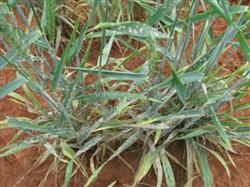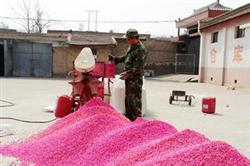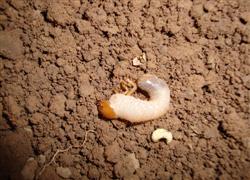Harm and control measures of wheat powdery mildew

The disease can damage the aboveground organs of wheat plants, but mainly leaves and leaf sheaths, and glumes and awn can also be damaged when the disease is serious. At the beginning of the disease, the white mildew spot of 1~2mm appeared on the leaf surface, and then gradually expanded into nearly round to oval white mildew spot, and there was a layer of white powder on the surface of the mildew spot, which scattered immediately in case of external force or vibration. These powders are the mycelium and conidia of the bacteria. In the later stage, the mildew layer of the disease became grayish white to light brown, and there were small black spots the size of needles on the spot, that is, the morphological characteristics of the closed capsule of the pathogen: parasitism on the surface of the mycelium, spread on the surface of the host and formed an haustorium in the epidermal cells of the host to absorb the nutrition of the host. At the stem end of the conidia perpendicular to the hyphae, there are 10-20 conidia in series, oval, colorless, 25-30 × 8-10 (um) in size, and the infectivity lasts for 3-4 days. The small black spots produced in the disease part, that is, the closed capsule of the pathogen, black spherical, the size of 163~219um, there are underdeveloped filamentous filaments 18% 52, containing 9% 30 daughter cysts. The ascus is oblong or ovate, containing 8 ascospores, sometimes 4. Ascospores round to oval, single cell colorless, uninucleate, size 18.8 ~ 23 × 11.3 ~ 13.8 (um). The ascomycetes are generally formed in the late growth stage of wheat and crack under suitable temperature and humidity after maturity and emit ascospores. The bacteria could not infect barley and barley powdery mildew could not infect wheat. Powdery mildew of wheat can form different physiological races under the long-term interaction with the host in different geographical and ecological environments, and the virulence changes rapidly. Occurrence conditions: wheat powdery mildew is a disease caused by fungi, usually the larger the closed capsule, overwintering with mycelium on winter wheat seedlings. In recent years, a large number of powdery mildew occurred due to the influence of varieties, cultivation system, fertilizer and water, and climatic conditions, which led to the early withering of wheat leaves, the decrease of spike rate and the decrease of 1000-grain weight, which seriously affected the quality and yield of wheat. Wheat powdery mildew is sensitive to temperature and humidity. The temperature in Huang-Huai wheat region is low before winter, and the disease is not easy to occur. In the early spring of the following year, when the temperature rose to 12 degrees, the diseased seedlings developed conidia and were infected for the first time. When the ambient temperature is suitable and the humidity is more than 70%, it is easy to cause disease epidemic. Harmful symptoms: wheat powdery mildew mainly harms the leaves, initially forming scattered white filamentous mildew spots on the leaf surface, gradually expanding and combining with oval mildew Chueh, which can cover most or all of the leaf surface in severe cases, the thickness of the mildew layer is about 1 mm, and then turns gray to brownish gray. The damaged leaves turned yellow and withered in the early stage, the diseased plants were short, and the heavy ones could not form ears. The disease can damage the aboveground organs of wheat plants, but mainly leaves and leaf sheaths, and glumes and awn can also be damaged when the disease is serious. At the beginning of the disease, the white mildew spot of 1~2mm appeared on the leaf surface, and then gradually expanded into nearly round to oval white mildew spot, and there was a layer of white powder on the surface of the mildew spot, which scattered immediately in case of external force or vibration. These powders are the mycelium and conidia of the bacteria. In the later stage, the mildew layer of the disease became grayish white to light brown, and there were small black spots the size of needles, that is, the closed capsule of the pathogen. Control measures: selecting disease-resistant varieties, sowing at the right time, reasonable close planting, formula fertilization to prevent excessive plant growth caused by partial application of nitrogen fertilizer, good light transmission and ventilation of the population, and the decline of disease resistance. Timely drainage and irrigation, so that there is no stain and no drought, and the plant grows healthily. Mix seeds with 15% pink rust of 0.03% dry seed weight. From booting to heading stage, 70% methyl topiramate 1000 times liquid or 16% tetrandrum wettable powder and other pesticide spray are used per mu, usually twice at an interval of 10 days, and the control effect is about 90%.
- Prev

Opinions on wheat sowing and prevention and control of diseases, insect pests and weeds at seedling stage
Seed dressing of wheat can prevent soil-borne, seed-borne diseases and some insect pests, such as total erosion disease, root rot, sheath blight, scattered black spike and so on. Attention should be paid to: 1. The type of drug use should be determined according to the occurrence of diseases and insect pests. If the wheat seedling pest occurrence is very light, the disease occurrence is serious, only uses the fungicide to mix the seed, does not need to kill.
- Next

Control of Underground pests of Wheat in Spring
The main underground pests are grub, mole cricket and golden needle worm, among which golden needle worm is the most harmful to wheat. The peak damage period of underground pests after the Spring Festival is from mid-March to early April. They bite off the roots of wheat, resulting in serious lack of seedlings and broken ridges, which have a great impact on wheat yield. In recent years, more and more underground pests have been treated.
Related
- The first cup of black tea in spring, the flavor and history of tea gardens in Kenya, Africa
- The computer can not only choose potatoes, but also grow tea rice. AI will grow winter oolong tea champion.
- It is not only the inflated tea bitten by insects, but also engraved with the four seasons tea in Beipu.
- The Oriental Beauty Tea Festival in Zhuxian County takes the stage at the weekend to experience the plus-size feast of oil tea.
- & quot; Oriental Beauty Tea & Exploration of Emei in Hsinchu, the hometown of quot;
- The new variety of strawberry "Tainong 1" dessert is the first choice with mellow aroma. Crimson gorgeous
- History of Tea in Taiwan: from Wild Inner Mountain to Export Tea Garden
- Two types of Taiwan Oriental Beauty Black Tea won the British three-Star Award for Childhood Tea Xiang Zhang Jiaqi changed from pilot to champion tea maker.
- Banana species and varieties: the planting history of Taiwan Xianren banana and dwarf banana is long, is banana disease resistant?
- Coffee planting Technology: Qianjie Coffee from Seedling to harvesting

